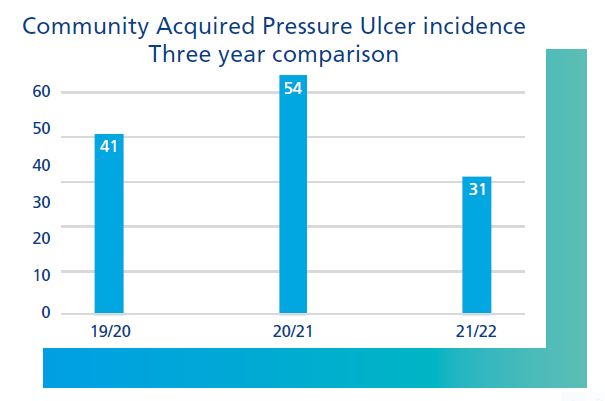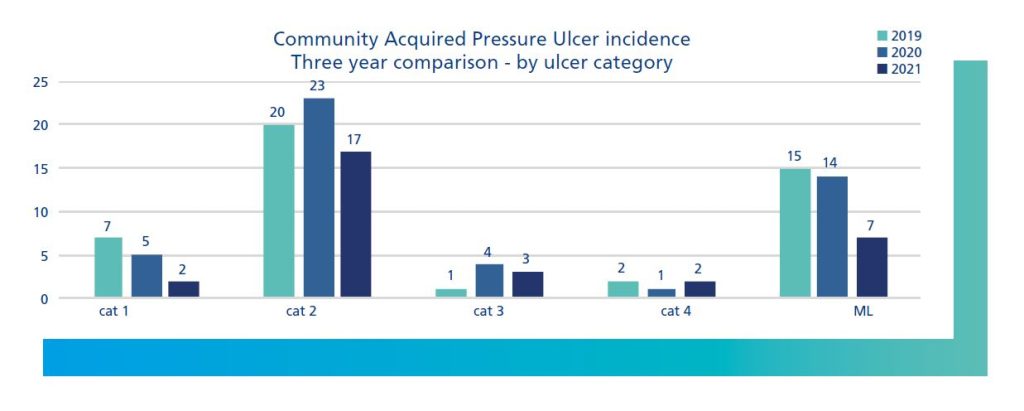Reducing patient harm from pressure damage is a key priority at the Newcastle Hospitals and this year (2021/22) we have focused on reducing the rate of community pressure damage, specifically community acquired pressure damage in patients under the care of our District Nursing Teams.
The increase in patient age, acuity and frailty means that the Trust is seeing more patients with a higher risk of acquiring pressure damage.
It is therefore essential that the Trust identified this as a priority to ensure the risks of this are mitigated with accurate assessment and plans of care, together with the implementation of best practice care.
What we aimed to achieve?
- Significantly reduce community acquired pressure ulcers (specifically those graded category II, III and IV).
- Development of dashboards which allow community teams to have a visual aid of where pressure ulcers are occurring, allowing ownership and enabling these teams to make improvements.
- Undertake quality improvement work on targeted localities who report the highest number and rate of pressure damage.
- Increase the visibility and support provided by the Tissue Viability team to frontline clinical staff to assist in the prevention of pressure ulcers.
- Ensure we have a skilled and educate workforce with a sound knowledge base of prevention of pressure ulcers and quality improvement methodology.
What we achieved?
- A new Pressure Ulcer Prevention Pathway was developed to guide and support staff. The pathway has been shared to all NHS Adult Community Services. Work is ongoing to ensure that this is fully embedded into practice.
- A robust programme of education was developed by the Tissue Viability Team delivering regular ‘Pressure Ulcer Prevention’ (PUP) updates across the city. Sessions were well attended by staff from community nursing and specialist services. Targeted pressure ulcer update sessions were implemented in teams reporting community acquired category III or IV pressure ulceration following Root Cause Analysis (RCA).
- Promotion of the ethos that PUP is the responsibility of all NHS staff regardless of where it was encountered by patients in their care journey.
- Inspired by Collaborative Newcastle, educational sessions were offered not only to Trust staff, but also to staff working in private organisations such as residential and nursing homes, and to domiciliary carers overseen by private care agencies and Local Authority. This promoted consistent messages across all care providers and ensured that preventative care interventions aligned with current best practice.
- Data collected over the previous three years (January 2019–December 2021) shows that pressure ulcer incidence in community is on a gradual downward trend (49, 47, 45). Data was then analysed by financial year (April 2019–March 2022) in alignment with the period set out for the Trust Quality Account and it is this that has been utilised to demonstrate the reduction in community acquired pressure ulceration. In the last 12 months we have attained a 42.6% overall reduction in community acquired pressure ulcers and a 24.4% reduction when using 2019 data as a pre-pandemic comparator.

There has been a reduction in Category I (60%), Category II (26%), Category III (25%) pressure ulcers and Moisture Lesions (ML) (50%).
The overall number of community acquired pressure ulceration remains small.
Category IV pressure damage has increased by 100% but this accounts for a very small proportion of community acquired pressure ulceration, two ulcers during the last 12 months.

Engagement with the RCA process from district nursing teams reporting community acquired category III and IV pressure ulceration has demonstrated improvements in the frequency of risk assessment and skin inspection, quality of nursing documentation and therefore patient care.
Five RCAs have been undertaken in the last 12 months with no RCAs being called since December 2021. The turnaround time of two weeks has been observed and aligns with the Trust’s expectation for investigation. This has ensured that we are able to meet the timeline set by the commissioners with regards to Serious Incident reporting.
How we measured success?
- Pressure Ulcer Incidence was measured through monthly analysis of Datix reporting. District Nursing Cluster Co-ordinators reviewed all reported community acquired pressure ulceration to ensure accuracy in reporting. A final check was then undertaken by the Tissue Viability Team to validate accuracy. Incidence data was presented monthly at the Clinical Governance meeting.
- Dashboards produced weekly by the Quality Team using data submitted by District Nursing Teams via a weekly audit tool. These were circulated to District Nursing Cluster Co-ordinators for dissemination to their District Nursing Teams.
- The Community Tissue Viability Team monitored the amount of RCAs completed and create action plans in response to the findings of each RCA investigation.